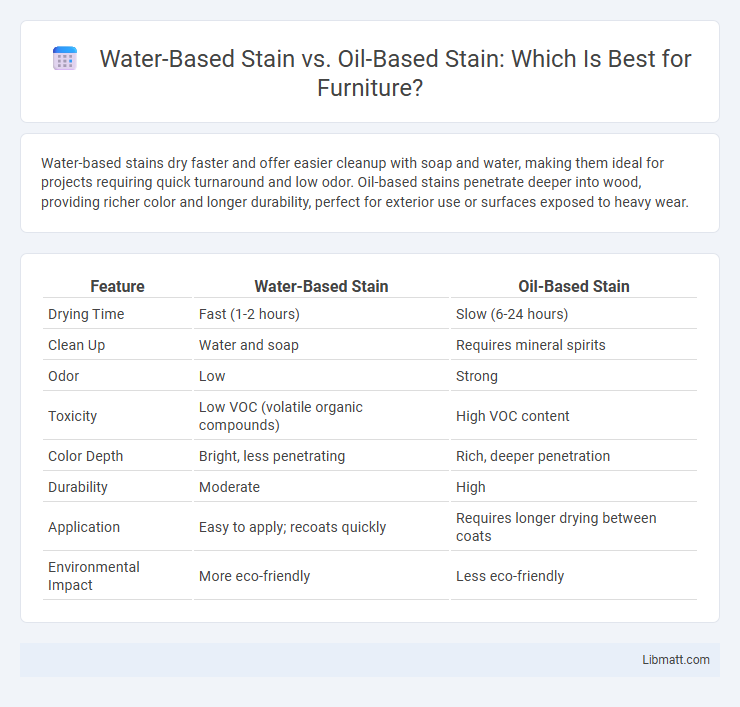Water-based stains dry faster and offer easier cleanup with soap and water, making them ideal for projects requiring quick turnaround and low odor. Oil-based stains penetrate deeper into wood, providing richer color and longer durability, perfect for exterior use or surfaces exposed to heavy wear.
Table of Comparison
| Feature | Water-Based Stain | Oil-Based Stain |
|---|---|---|
| Drying Time | Fast (1-2 hours) | Slow (6-24 hours) |
| Clean Up | Water and soap | Requires mineral spirits |
| Odor | Low | Strong |
| Toxicity | Low VOC (volatile organic compounds) | High VOC content |
| Color Depth | Bright, less penetrating | Rich, deeper penetration |
| Durability | Moderate | High |
| Application | Easy to apply; recoats quickly | Requires longer drying between coats |
| Environmental Impact | More eco-friendly | Less eco-friendly |
Introduction to Water-Based and Oil-Based Stains
Water-based stains offer faster drying times and lower odor, making them ideal for indoor projects where quick use and minimal fumes are important. Oil-based stains penetrate deeper into wood fibers, providing richer color and enhanced durability suitable for outdoor furniture and high-traffic areas. Choosing the right stain depends on your project's needs for appearance, drying time, and environmental considerations.
Key Differences Between Water-Based and Oil-Based Stains
Water-based stains dry faster, typically within 1-2 hours, and offer easier cleanup with water, making them ideal for quick projects and low-odor environments. Oil-based stains penetrate deeper into wood fibers, providing richer color and longer-lasting protection but require solvents like mineral spirits for cleanup and have a longer drying time, usually 24 hours or more. The choice between water-based and oil-based stains depends on factors such as desired finish durability, application environment, and drying time preferences.
Application Process Comparison
Water-based stains dry faster, offering easier clean-up with soap and water while allowing multiple coats within a shorter timeframe. Oil-based stains penetrate wood deeply, requiring mineral spirits for clean-up and longer drying times between coats to achieve a richer finish. The choice depends on project timing, desired wood enhancement, and maintenance preferences for application efficiency.
Drying Time and Cure Rate
Water-based stains typically dry within 1 to 2 hours and fully cure in about 24 to 48 hours, allowing for faster project completion and recoat times. Oil-based stains require a longer drying time of 6 to 8 hours and can take up to 7 days or more to fully cure, which enhances durability and resistance to wear. The quicker drying and curing rate of water-based stains make them ideal for time-sensitive applications, while oil-based stains offer a more robust finish suitable for high-traffic or exterior surfaces.
Color Options and Finish Results
Water-based stains offer a broader spectrum of vibrant color options, allowing for easier blending and customization to achieve specific hues. Oil-based stains provide deeper, richer tones with a longer drying time that enhances the penetration into wood fibers for a more uniform finish. The water-based stain typically results in a semi-transparent, lighter finish, while oil-based stains deliver a glossy, durable coat with enhanced wood grain definition.
Durability and Longevity
Water-based stains dry faster and resist fading and peeling, offering excellent durability for exterior wood surfaces exposed to harsh weather. Oil-based stains penetrate deeper into wood fibers, providing superior protection and longevity, especially for high-traffic or heavily used areas. Choosing the right stain ensures your wood maintains its appearance and durability over time, matching your specific project needs.
Environmental and Health Impacts
Water-based stains emit fewer volatile organic compounds (VOCs), making them a healthier choice for indoor use and reducing environmental pollution. Oil-based stains contain higher levels of VOCs, contributing to air quality degradation and posing greater health risks such as respiratory issues. Choosing a water-based stain minimizes your exposure to harmful chemicals while supporting eco-friendly practices.
Maintenance and Recoating Requirements
Water-based stains offer easier maintenance and quicker recoating times due to their fast drying properties and lower VOC content. Oil-based stains typically require longer curing periods before recoating and demand more intensive surface preparation, such as sanding and solvent cleaning. Regular upkeep for oil-based stains involves periodic reapplication to prevent peeling and fading, whereas water-based stains often need more frequent but simpler touch-ups to maintain vibrancy.
Cost Analysis and Budget Considerations
Water-based stains generally cost more upfront compared to oil-based stains but offer lower long-term expenses due to faster drying times and easier cleanup, reducing labor costs. Oil-based stains tend to be less expensive initially, but their longer drying periods and the need for solvents can increase overall project costs. Budget considerations should factor in not only material prices but also application time, maintenance frequency, and environmental compliance, which often favor water-based stains for cost efficiency.
Choosing the Right Stain for Your Project
Water-based stains dry faster, emit fewer odors, and offer easier cleanup, making them ideal for interior projects where quick turnaround and low VOCs matter. Oil-based stains provide deeper penetration and richer color, enhancing durability especially on outdoor wood exposed to harsh weather. Your choice depends on project location, desired finish, and maintenance preferences, ensuring the stain complements your woodwork's longevity and appearance.
Water-based stain vs oil-based stain Infographic

 libmatt.com
libmatt.com